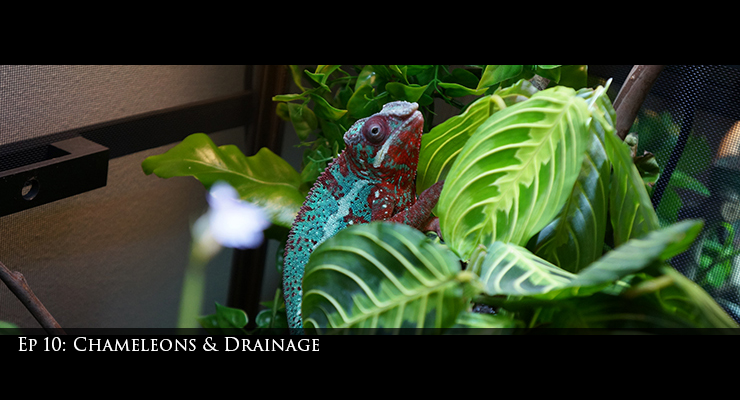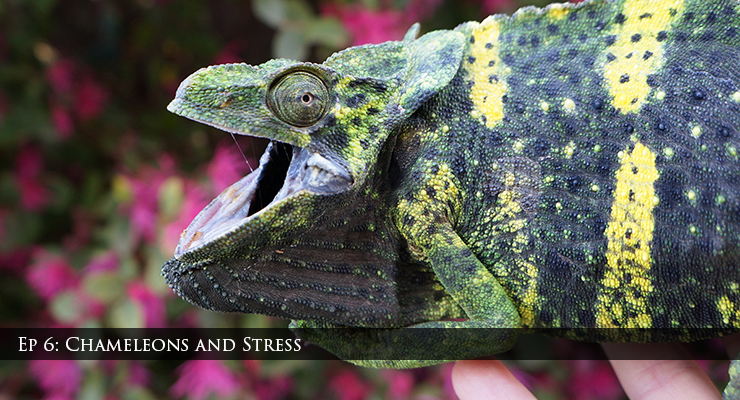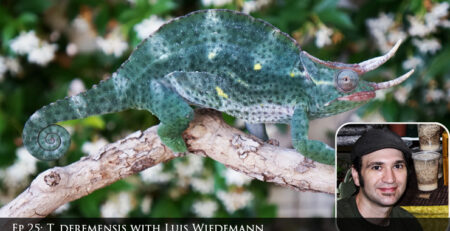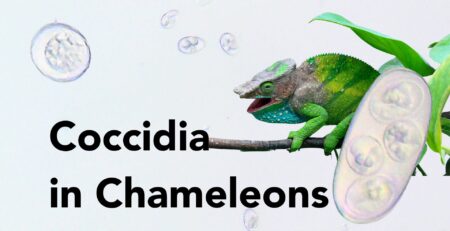A Beginner’s Guide to Fighting Reptile Parasites
We all know parasites are an issue with our captive reptiles, but not all of us have a microscope or would know what to do with one if we did. Today I am going to give you the bare bones, high level introduction to parasites that requires no previous knowledge, but will make you highly effective in fighting the parasites that want to move in on your reptile.
Note: This topic is discussed in the weekly Chameleon Academy Newsletter and is reviewed in both a YouTube video and a podcast episode. The video and podcast are separately produced and will provide different perspectives. Click here to join in with the weekly newsletter discussions: Chameleon Academy Newsletter sign up
Video Player
Podcast Player
Let's get started understanding reptile parasites
I am going to talk about how to structure your husbandry to provide the best defense against parasites coming into your home. Even if you have a single reptile or that reptile is captive hatched, parasites can find their way in. If you have ever been to a reptile shop or reptile expo or have touched the same door knob as someone who has you could easily be bringing back parasitic material home. I know it sounds paranoid, but, really, parasites have evolved to get their ova and oocysts to the right host in the vast forest of Madagascar. Hopping around our reptile community is not the challenge we might think it is. In fact, there is a scientific study by Dr. Rachel Ellerd (now Siu) documenting this spread within the community. It is real and we all need to be aware that there is a problem.
This article is specifically presented for people who do not know much about parasites and do not have microscopes, but the information here actually comes from one of many lessons in a complete digital course about hunting parasites. If this topic fascinates you and you want to learn so much more then I’ll be giving more details at the end. But, for now, let’s assume no previous experience and no microscope. How can you fight parasitic infections with husbandry whether you know you have parasites or not?
To set the stage, there are a wide range of parasites types. I will be talking about the most common microscopic internal parasites we run into like pinworms, hookworms, coccidia, and various protozoa.
Each reptile group has specific super villain parasites, but what I am going to go over here applies to all our reptiles. You are used to me focusing in on chameleons, but a great number of us chameleon keepers work with other reptiles. I am known for my work with chameleons, but I love geckos, frogs, emerald tree boas, and much more so this episode serves all our mini dragons.
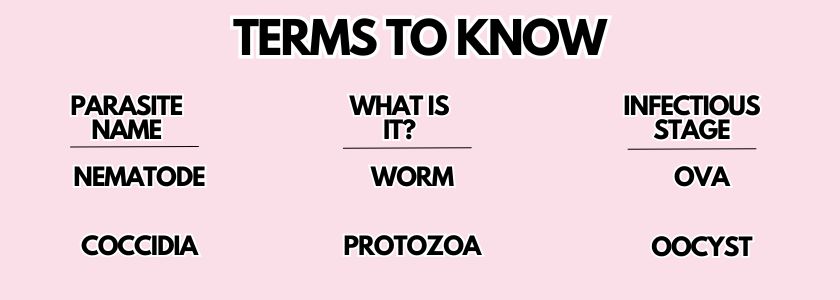
I am going to keep terminology very basic through this entire article. I have many resources for learning, but I want the action item today to be action orientated. There are only a few terms I would like to introduce you to and that will be enough to get us through the examples I will give.
Nematode: This is a type of worm. Only a small number of nematode species are parasitic, but the ones that are play a major role in our efforts.
Ova: This is a nematode egg. The words can be used interchangeably, but the official term for nematode eggs is ova.
Coccidia: A type of parasitic single celled protozoa. The only thing you need to know about coccidia right now is that it is a parasite that is tough to kill and is reproductive form is called an oocyst.
Oocyst: This is not an egg at all, but it serves the same function for the coccidia parasite. WhenI mention an oocysts I am talking about the infectious form of coccidia
Cyst: Many parasites do something called “encystig” this is where they curl into a protective ball and wait until conditions are appropriate to “excyst”, or come alive again and continue their lifecycle. It isn’t important to know this for this article, but the difference between a cyst and an oocyst is that a cyst is dormant and there is growth and transformation going on inside the oocyst. But you can save that little bit of trivia for game night. We won’t need it today!

The plan of attack on the reptile parasites
The first thing we need to do is know how our enemy operates so we can identify and exploit their weaknesses. Parasites have a somewhat complex lifecycle and a bunch of parasite nerds talking can sound like a different language. But what I am about to tell you is all you need to know for the majority of the parasites we are fighting. The adult form lives in the reptile’s body and reproduces. The reproductive forms, which have all sorts of names such as ova, oocysts, cysts, and such, are then sent out of the body in the feces where they have to hitch a ride, somehow, to the mouth of the correct reptile species where they can mature to reproducing adults and continue the cycle. What you need to know is that, even though they are too small for us to see, that lifecycle has three major weaknesses we can take advantage of.
We can eliminate the reproducing adults.
We can remove any infectious forms they send out in the poop
And we can disrupt the path back to our reptile’s mouth.
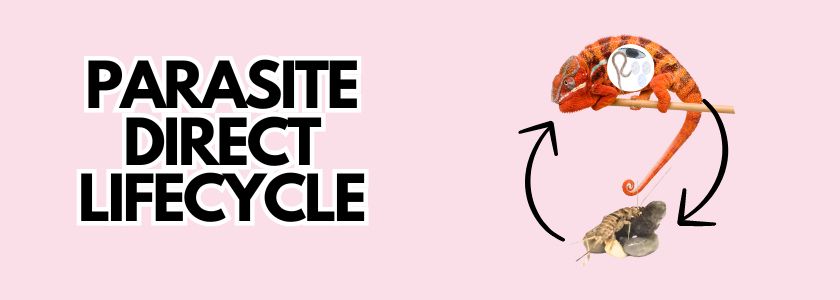
Eliminating the adult, reproductive reptile parasite
Let’s talk Reproducing adults. These are the life stages that live inside your reptile’ s body and produce infectious material that they send out into the world via the poop. These can be worms that mate for life and spend their existence absorbing nutrients and producing ova, meaning eggs. These can be single cell Protozoa called coccidia which get into the intestines and then replicate like mad before transforming themselves into oocysts and going out the back end to find the next host. We can know they are there if we do fecal tests, but that requires you to have a microscope or bring a fecal sample into the vet. And, that is what people do when their reptile shows signs of lethargy and being sick. But before that, there is no real sign that there may be anything we need to address. I recommend doing at least an annual fecal check with your vet just to be safe. But, in-between those check-ups, when we have no real reason to be concerned, we still can bring to bear the most potent general purpose, anti-parasite agent that we have.
Quiz time: What is the #1 killer of internal parasites and our greatest ally in this fight.
Answer: Your reptile’s immune system.
Do you know why some of these parasites reproduce by create hundreds, thousands, or even hundreds of thousands oocysts, ova, or what not? Part of that is blanketing the forest floor with their eggs in the hope that a couple will end up in the right reptile’s mouth to continue the species. But also, they need those numbers because the reptile’s immune system lays waste to these invaders and the parasites have to try to out produce and/or evade the immune system through some sort of deception.
In fact, in the wild, parasites and reptiles live in a balance where the parasites can continue their life as long as they fly under the radar. This is why you are sometimes surprised to hear from your vet that your reptile has parasites. He looks and acts healthy! Well, yes, because everything is in balance. The parasites actually don’t want to get out of hand because killing their host kills them. So what happens that suddenly the parasites spiraled out of control and made the reptile sick? Remember, this is not a victory for the parasites! They want to fly under the radar and be unnoticed. They do not want to get to the point where they are noticeably slowing the reptile down because that means their home is more likely to be eaten. So something unexpected and unwanted for both the parasites and the reptile is happening.
It is simple. Parasitic infections spiral out of control when there are more parasites than the immune system can hold back. This happens either because the immune system has been weakened or else the reptile got a super dose of parasite eggs.
So how do we prevent these two conditions from happening? The first step is understanding what is going on. The second is making it really hard for the parasites to complete their lifecycle.
Our two focus points are 1) we need to strengthen the immune system and 2) we need to prevent an overload of eggs from getting back to our reptile.
Attacking reptile parasites by partnering with the immune system
A reptile’s immune system is just like ours. It can work at top form when we are in top health. But when we do not exercise or get enough sleep, eat healthy foods, drink enough water or keep warm enough, our body gets weak and our immune system gets weak. And it is the same with our reptile. This is why I say top notch husbandry is the best defense against parasites.
Have you heard of a respiratory infection? Same principle. Your reptile is breathing in bacteria each and every breath. The bacteria comes into the lungs, settles on the surface and tries to reproduce. But it can’t get far because the immune system detects a foreign body and kills it all. No mercy. Just wipes it out. A respiratory infection occurs when the immune system is not strong enough to kill all the bacteria and the bacteria start replicating faster than the weakened immune system can keep up with. The reason we give antibiotics is to give the immune system time to rest and recover. It is the same dynamic with parasites. And, just a note, our common bacterial infections are not considered parasitic. I am just including bacteria into this discussion because it fits so well and why not learn a little extra. Free, on the house! So, same dynamics as far as immune system, but bacteria is not classified as a parasite. Don’t report me to the Calummanati, k?
The immune system is supported by husbandry. The Right temperature, humidity, hydration, nutrition.… Keeping the body physically strong. But, you say, I do that anyways and haven’t run into a problem. Exactly, and that is our goal. Do you know why so many people are surprised by finding parasites? It is because their reptile is not showing any sickness. Well, that can be, in a big part, because that reptile is getting proper husbandry and the immune system is strong enough to fight off the parasites you didn’t even know were there! Now, as wonderful as this sounds, it is still worth it to do that annual fecal test and medicate for any parasites that are found. All living beings have good days and bad days. If there are one too many bad days an infection can get out of hand. So, treat it even if your reptile is in the top of health right then.
It is when the body machine is not given the right parameters that the immune system cannot do its job. This comes from both physical stress – temp, humidity, hydration, nutrition and emotional stress – cohabitation issues, constantly feeling insecure. Yes, reptiles are just like us. When we are emotionally stressed we get physically sick. And, this is the reason why this is a spiral to the death for our reptiles. Both parasites and bacteria will just keep reproducing and a compromised immune system will become more and more overwhelmed until it just fails.
How medicine supports the immune system
And, this is where medicine comes in. It takes over for or helps the immune system. What ever is spiraling out of control, the medicine either kills it for the immune system or else halts the spread to give the immune system time to catch up. So, the medicine isn’t really fixing anything. It is keeping the immune system from being overwhelmed. And this is why medicating for a bacterial infection is not the solution. It just gives you time to figure out the solution.The solution is fixing whatever the situation was that caused the immune system to fail in the first place. That is because the bacteria will be ever present. You need to figure out where your husbandry failed in the first place and fix that or else the same condition will come back. At least with parasites, if we are successful in eradicating them it takes a new introduction to get a reinfection.
Now, as effective as it is, the immune system is not all powerful. Parasites have found ways to evade it. Nematodes, or worms, can evade the immune system and live for many years blissfully producing eggs. Husbandry won’t get them to stop. That would have to be medication. But for something like coccidia, whose strategy is to replicate itself to horrifying numbers, the immune system is a major player in reducing that infection. But even with parasites that are successfully hiding from the immune system and producing eggs, it is husbandry that can stop the downward spiral of introducing more and more of the parasites into the system. You see, most parasites do not auto infect, which means they produce eggs that hatch inside the host they are in. A few do, but most don’t. Putting all your eggs in one basket is a quick way to lose your entire genetic line so it isn’t a good long term survival strategy. And having to go outside the body puts them in our husbandry crosshairs. This is why you can be highly effective in fighting parasites, or bacterial infections, without knowing that they are there.
Captivity puts the odds in favor of the parasites
So, good hygienic husbandry makes sure that the immune system is strong enough to handle the normal every day attacks our reptile gets from bacteria and parasites. But, if you remember, the other way this can go south is if your reptile gets a super dose of parasites that overwhelms a healthy immune system. How does this happen? Well, this is simple. It is an artifact of our caging. In the wild, parasites have to produce enough infectious eggs and such to not only make it through the immune system gauntlet, but also they have to blanket the forest floor with so many that a couple might make it back into the right mouth to continue the population. Can you imagine how many ova and coccidia oocysts die on the forest floor because they were never picked up by a fly or rat or whatever? So you have this super production of eggs by parasites. What happens when you take this super production of eggs and enclose it in the small area of the cage with the exact definitive host all those eggs are looking for? And then you put a bunch of feeder insects in that small space. We have taken the wild dynamic that hopes to get a couple of coccidia oocysts into the right mouth in the vast forest and increased the chances of success a ridiculous amount by putting all the elements into a small area. The idiom “it’s like shooting fish in a barrel” is the exact situation. Except it is the chameleon in the barrel and the parasites shooting.
The parasite is expecting all the oocysts in the one poop to dissipate in the rain and be spread out over the various insects that walk or fly on by. What are the chances that the right type of insect drops down, picks up oocysts and flies to be eaten by the exact right reptile species? Pretty low. Now, what if 100% of the insects introduced are the right insect and 100% of them are eaten by the right reptile species. You see how we mess up the numbers? So, yes, as the mini gods of this mini system we need to reintroduce challenge for the parasites. This is where meticulously cleaning up the poop in an obsessively timely fashion comes in.

Remove infectious parasite material
Most of the parasites we are dealing with have the weakness in their lifecycle that their reproductive eggs and cysts have to go out through the feces. And so we are going to attack that choke point. Everything that that poop hits on the way to the floor needs to be cleaned or removed. And then the plop site needs to be cleaned and disinfected. And here is a challenge for some of us. I specialize in chameleons. We chameleon keepers are lucky because we can arrange our cages so that branches don’t overlap each other and perching branches are behind plants instead of over plants and so we can actually increase the chances that the poop doesn’t hit anything on the way down to a bare plastic floor. But a terrestrial animal like a bearded dragon will be pooping and then spreading the poop all over the place just by walking through the cage. I had a frilled dragon and 30 minutes after I meticulously cleaned and disinfected his cage he would have pooped and spread it far and wide. And then, of course, there are frogs and turtles that swim in the water that they poop in so each of our communities has their own challenges in cleaning up poop before it can spread the parasitic infectious material. Talk to the experienced members in your community and ask what strategies they use to maintain hygienic conditions.
Spot cleaning is where we just pick up the poop with a paper towel. The more you supercharge your spot cleaning the more effective you are at thwarting any parasites in the poop. This is relatively simple if you have a plain floor. Paper towels clean up the poop, accelerated hydrogen peroxide, or your cleaner of choice, to disinfect the area, and then wipe up the area. If I am doing a quarantine period I will use disposable gloves to ensure I do not spread infectious material while I am cleaning.
If you have a soil floor then you do the best you can to get any soil which is around the poop, but it will be very difficult to do any sort of attempt at getting everything.
Disrupt the parasite return path
Luckily there is another stage to this lifecycle and we have another chance. The ova and oocysts have to get from the poop to the mouth of the reptile. This means that you can break that leg of the lifecycle by strictly controlling what your reptile eats. If they can eat from your hand or tongs do that. If they will only eat from a food bowl then give a food bowl and remove after 30 to 45 minutes depending on your situation. You are trying to avoid escaped feeder insects that will run around the floor and bring back parasitic eggs.
So by keeping the parasitic lifecycle in mind you can give excellent hygienic husbandry whether you know parasites are there or not. And, you should! By keeping these high standards you may even have a parasitic infection crop up and then resolve itself. That would be a sign that you are doing it right. Though, not sure how we could measure that unless you have a microscope you could use.
That said, please do not take anything that I have said to suggest that you no longer need a veterinarian. What we are doing here is providing excellent husbandry. But, if your pet is acting sick at all then do not hesitate to get medication from the vet for the particular condition or parasite. Remember that if your reptile is showing sickness then the condition has advanced beyond that which the immune system can handle. I can’t say your reptile won’t work through it, but I will say that once it is bad enough that you notice it, it is bad and you don’t want to play with chances.
Special Topic: How do parasites spread in the reptile community?
Where the forest has a network of insects and other organisms to carry parasites around and to their next host, the reptile community has people to fill that role. I don’t want to make you paranoid, but we also have to be realistic. How many times is someone given the surprise that their one reptile pet has parasites from a routine fecal exam? And, what d they do? They try to figure out who is to blame. Is it the breeder? Is it the feeder company? Is it wild insects you caught and fed? It will be very difficult to tell. Because these are possibilities. But what is also a possibility is that when you went to a reptile show last year just to look you brought home coccidia oocysts that were just waiting around for your new baby reptile to show up six months later. You don’t even have had to have handled a reptile or touched one. All you had to do is touch the same door knob to the bathroom as someone that did. But you washed your hands? Did you do it with one of those knob faucets where your clean hands turn it off with the same knob your dirty hands turned it on? Have you picked up anything from a reptile store where the employees handed you something?
Does all of this sound far fetched? Well, does it sound more far fetched than a microscopic cyst falling from the tree canopy finding its way 50ft back up into the mouth of a chameleon in the canopy. They have developed an amazing way of hitching rides and we are doing a bang up job taking the place of insects with our hands that just have to touch everything. Be aware that you can get parasites on your hands if someone you know knows someone who has a reptile. This huge world isn’t as big as we think it is.
Special Topic: Handling your reptiles
Parasites rely on other organisms to carry their ova, oocysts, and such to the next host. They have developed excellent capabilities to hitch rides. This, unfortunately, means that the most effective transfer of infectious material is your hands. We brush the decorations in the cage when we change out food cups and then use our hands to close the cage door. Then the oocysts are waiting on the door latch for you to pick up again with your freshly cleaned hands. Handling your reptile opens your hands up to receiving parasitic material. While it is true that the parasitic material comes from feces, you are gathering whatever your pet walked through. And anything you may touch spreads the eggs. I know first hand how paranoid you can get and how many times you have to wash your hands and how it can drive you a little crazy trying to keep track of everything you have touched. Just keep this in mind if you regularly handle your reptile. Consider doing proactive fecals twice a year just to be safe.
Special Topic: Cryptosporidium
Coccidia is a single celled protozoa that is a huge pain and gets everywhere. But we have the medication to control it. Cryptosporidium is a single celled protozoa that is similar to coccidia in lifecycle with some concerning differences. The first is that there are no medications that are effective against cryptosporidium. The second is that crypto is one of the few parasites that auto infects. Which means once your reptile has crypto you cannot get rid of it via medicine and you cannot get rid of what is already inside by cutting off the return path. Now, you absolutely should cut off the return path so the thick walled oocysts that do go out don’t come back in and make the problem that much worse! But with cryptosporidium, husbandry is your only hope to control the situation! The immune system is the only thing we have to kill the crypto inside the body and your meticulous husbandry makes sure the problem does not become worse. So, in one way, saying you can fight parasites with husbandry seems overly simple when faced with a killer like cryptosporidium, but, ironically, hygienic husbandry is the only thing we have to try to save the life of a reptile with cryptosporidium. Cryptosporidium is a devastating parasite.
Special Topic: Crickets and pinworms (Oxyurids)
Now, we have to address an urban legend that has been bouncing around the community for a while. And that is that parasites come in with feeder insects. This was circulating so much that a scientist did a peer reviewed paper experimenting to see if he could find any evidence of this. The reason why there is so much scrutiny on this is because once you know the parasitic lifecycles you realize that the only way for this to be a problem is if a reptile just like yours is pooping over the feeder farm bins. And that is highly unlikely. Now, what is possible is oocysts and ova could be coming off the hands of the person bagging up your feeders. This is more likely to happen at a reptile pet shop or reptile expo where an employee is cleaning cages and then getting something for you. This is highly unlikely in a feeder farm situation where the employees do not have access to interacting with different species of reptiles during the work day. If you would like to read it yourself, you can find it here: An Evaluation of the Gray Cricket, Acheta domestica, as a Source of Oxyurids for Reptiles. Crickets can carry parasites that look like reptile parasites so maybe that is where this originated? I do not know. But with the evidence in this paper, we need a similar type of evidence to promote this concept out of Urban Legend status.
Where to learn more about reptile parasites
So, let’s summarize what we went over.
Parasites can be a life threatening problem – even if you have only one captive hatched reptile
The parasite lifecycle has three weak points for us to hit. The adult production, the feces distributions and the feeder insect conduit.
Adult production can be eliminated by partnering solid husbandry strengthening the immune system and, in the case of a positive parasite ID, medication to help the immune system knock down the invaders.
Distribution of infectious material can be broken by obsessive spot cleaning of feces.
And the feeder insect return conduit can be disrupted by strict supervision during feeding time.
This episode is an excerpt from a digital course that is designed to introduce the world of reptile parasitism to the beginner. It is called Hunting Microscopic Chameleon ParasitesHunting Microscopic Chameleon Parasites. While chameleon is in the name and I definitely have the bulk of my experience in chameleons, the material is the same for the other species of reptiles. I have had alumni check bearded dragons, boas, frogs, and geckos. Coccidia is coccidia no matter what species. So, all reptile and amphibian keepers are welcome and will benefit from this course.
This husbandry approach lesson is just one lesson in the entire course which will teach you parasite lifecycles, how to purchase and use a microscope, parasite identification, medicines, quarantine, husbandry aspects, and being a good partner with your vet for the health of your reptile.
The best part of this course is that it is community powered. The course is asynchronous so you can take it at any time and at your own pace, but there is a comment section on each lesson where you can ask questions and I will answer. And there is a forum for students, alumni, and me where we go over use cases so you can see how this material is being applied in real life. Add to that periodic live lectures in the lecture hall where we are able to speak to experts in the community. This course is designed specifically to take you from no previous experience to being able to do your own reptile fecal checks. You can monitor your reptile’s progress and share more data points with your vet. More than that, though, it has been educational and fun to learn about the world under the microscope and share it with others who have taken the class.
Join me for a weekly discussion about chameleons
Thank you for being part of this chameleon academy outreach. As always, every week has a topic which is presented in the weekly chameleon academy email newsletter. If you would like to join the conversation then sign up at chameleon academy dot com. The newsletter is a serious outreach for me. I know you are used to getting newsletters that are haphazardly thrown together to check a to-do box. But I put a great deal of effort into figuring out what is best for the community, where I want to take my herpetoculture, and writing substantial educational newsletters. So, try it out and see if it gives you the chameleon fix you are looking for!
And with that, I think it is time to send you back out into the world to be excellent to each other. Consider signing up for the newsletter or taking the plunge and diving into deeper knowledge of microscopic parasites by joining us in the Hunting Microscopic Chameleon Parasites course.
You can sign up for the newsletter here: Chameleon Academy Weekly Newsletter
You can join the class here: Hunting Microscopic Chameleon Parasites
And, with that, I think it is time for us to go out into that world and be awesome! Thank you for joining me on this journey to explore chameleon husbandry and the relationship between us and our chameleons. This is Bill Strand signing off. I will see you next time!



